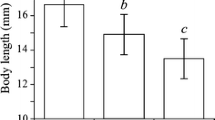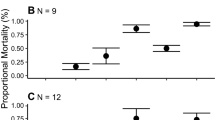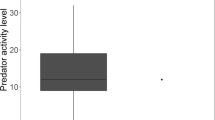Abstract
In species with restricted dispersal, traits may become genetically fixed leading to local adaptations. Therefore, predator avoidance in a prey species may differ between populations experiencing different predator regimes, but also between sexes within a population due to different vulnerability to predators. In this study we used male and female Gammarus pulex from two different predator regimes: fishless ponds, where invertebrates are the dominant predators and ponds with predatory fish. In the laboratory we examined refuge use, mortality, leaf decomposition rate and pair-formation in G. pulex when exposed to predator cues from either invertebrate predators or fish. Individuals from fish ponds spent more time in refuge and had a higher mortality than those from fishless ponds independent of predator cues. There was no effect of pond predator regime or predator cues on leaf decomposition rates. Further, fewer individuals formed pairs in G. pulex from fish ponds than from fishless ponds. Male G. pulex had a higher mortality and a higher decomposition rate than females independent of predator cues. However, there was no difference in refuge use between sexes. Our study shows that there are general differences in behaviour traits, both between predator regimes and sexes in G. pulex.





Similar content being viewed by others
References
Åbjörnsson, K., J. Dahl, P. Nyström & C. Brönmark, 2000. Influence of predator and dietary chemical cues on the behaviour and shredding efficiency of Gammarus pulex. Aquatic Ecology 34: 379–387.
Åbjörnsson, K., L.-A. Hansson & C. Brönmark, 2004. Responses of prey from habitats with different predator regimes: local adaptation and heritability. Ecology 85: 1859–1866.
Åbjörnsson, K., L.-A. Hansson & C. Brönmark, 2009. The influence of predator regime on reproductive traits in Gammarus pulex populations. Hydrobiologia 635: 215–225.
Abrams, P. A. & L. Rowe, 1996. The effects of predation on the age and size of maturity of prey. Evolution 50: 1052–1061.
Anholt, B. R. & E. E. Werner, 1998. Predictable changes in predation mortality as a consequence of changes in food availability and predation risk. Evolutionary Ecology 12: 729–738.
Benard, M. F., 2004. Predator-induced phenotypic plasticity in organisms with complex life histories. Annual Review of Ecology Evolution and Systematics 35: 651–673.
Bilton, D. T., J. R. Freeland & B. Okamura, 2001. Dispersal in freshwater invertebrates. Annual Review of Ecology and Systematics 32: 159–181.
Bollache, L., N. Kaldonski, J.-P. Troussard, C. Lagrue & T. Rigaud, 2006. Spines and behaviour as defences against fish predators in an invasive freshwater amphipod. Animal Behaviour 72: 627–633.
Bonduriansky, R., A. Maklakov, F. Zajitschek & R. Brooks, 2008. Sexual selection, sexual conflict and the evolution of ageing and life span. Functional Ecology 22: 443–453.
Brönmark, C. & L. A. Hansson, 2000. Chemical communication in aquatic systems: an introduction. Oikos 88: 103–109.
Carpenter, S. R. & J. F. Kitchell, 1993. Titel. Cambridge University Press, Cambridge.
Cooper, S. D., S. J. Walde & B. L. Peckarsky, 1990. Prey exchange rates and the impact of predators on prey populations in streams. Ecology 71: 1503–1514.
Cothran, R. D., 2004. Precopulatory mate guarding affects predation risk in two freshwater amphipod species. Animal Behaviour 68: 1133–1138.
Dick, J. T. A., 1995. The cannibalistic behaviour of two Gammarus species (Crustacea: Amphipoda). Journal of Zoology (London) 236: 697–706.
Douglas, P. L., G. E. Forrester & S. D. Cooper, 1994. Effects of trout on the diel periodicity of drifting in baetid mayflies. Oecologia (Berlin) 98: 48–56.
Dunn, A. M., J. T. A. Dick & M. J. Hatcher, 2008. The less amorous Gammarus: predation risk affects mating decisions in Gammarus duebeni (Amphipoda). Animal Behaviour 76: 1289–1295.
Elwood, R., J. Gibson & S. Neil, 1987. The amorous Gammarus: size assortative mating in G. pulex. Animal Behaviour 35: 1–6.
Felten, V., G. Tixier, F. Guerold, V. D. C. De Billy & O. Dangles, 2008. Quantification of diet variability in a stream amphipod: implications for ecosystem functioning. Fundamental and Applied Limnology 170: 303–313.
Fox, C. W., L. Dublin & S. J. Pollitt, 2003. Gender differences in lifespan and mortality rates in two seed beetle species. Functional Ecology 17: 619–626.
Galipaud, M., F. Dechaume-Moncharmont, A. Oughadou & L. Bollache, 2010. Does foreplay matter? Gammarus pulex females may benefit from long-lasting precopulatory mate guarding. Biology Letters. doi:10.1098/rsbl.2010.0924
Goedmakers, A., 1981. Population dynamics of three Gammarid species (Crustacea, Amphipoda) in a French chalk stream, Part II Standing crop. Bijdragen tot de Dierkunde 51: 31–69.
Härdling, R., H. Kokko & R. W. Elwood, 2004. Priority versus brute force: when should males begin guarding resources? American Naturalist 163: 240–252.
Holomuzki, J. R. & L. A. Hatchett, 1994. Predator avoidance costs and habituation to fish chemicals by a stream isopod. Freshwater Biology 32: 585–592.
Holomuzki, J. R. & T. M. Short, 1988. Habitat use and fish avoidance behaviors by the stream-dwelling isopod Lirceus fontinallis. Oikos 52: 79–86.
Kaldonski, N., C. Lagrue, S. Motreuil, T. Rigaud & L. Bollache, 2008. Habitat segregation mediates predation by the benthic fish Cottus gobio on the exotic amphipod species Gammarus roeseli. Naturwissenschaften 95: 839–844.
Krupa, J. J. & A. Sih, 1998. Fishing spiders, green sunfish, and a stream-dwelling water strider: male-female conflict and prey responses to single versus multiple predator environments. Oecologia (Berlin) 117: 258–265.
Kullmann, H., T. Thunken, S. A. Baldauf, T. C. M. Bakker & J. G. Frommen, 2008. Fish odour triggers conspecific attraction behaviour in an aquatic invertebrate. Biology Letters 4: 458–460.
Lewis, S. E., J. T. A. Dick, E. K. Lagerstrom & H. C. Clarke, 2010. Avoidance of filial cannibalism in the Amphipod Gammarus pulex. Ethology 116: 138–146.
Lima, S. L. & L. M. Dill, 1990. Behavioral decisions made under the risk of predation: a review and prospectus. Canadian Journal of Zoology 68: 619–640.
Mccarthy, T. M. & W. A. Fisher, 2000. Multiple predator-avoidance behaviours of the freshwater snail Physella heterostropha pomila: responses vary with risk. Freshwater Biology 44: 387–397.
McGrath, K. E., E. T. H. M. Peeters, T. H. M. Edwin, J. A. J. Beijer & M. Scheffer, 2007. Habitat-mediated cannibalism and microhabitat restriction in the stream invertebrate Gammarus pulex. Hydrobiologia 589: 155–164.
Mcintosh, A. R. & B. L. Peckarsky, 1999. Criteria determining behavioural responses to multiple predators by a stream mayfly. Oikos 85: 554–564.
Mcintosh, A. R. & C. R. Townsend, 1996. Interactions between fish, grazing invertebrates and algae in a New Zealand stream: a trophic cascade mediated by fish-induced changes to grazer behaviour? Oecologia (Berlin) 108: 174–181.
Mcpeek, M. A., 1990. Behavioral differences between enallagma species odonata influencing differential vulnerability to predators. Ecology (Washington DC) 71: 1714–1726.
Nyström, P. & K. Åbjörnsson, 2000. Effects of fish chemical cues on the interactions between tadpoles and crayfish. Oikos 88: 181–190.
Nyström, P., O. Svensson, B. Lardner, C. Brönmark & W. Graneli, 2001. The influence of multiple introduced predators on a littoral pond community. Ecology 82: 1023–1039.
Obernborfer, R. Y., J. V. Mcarthur, J. R. Barnes & J. Dixon, 1984. The effect of invertebrate predators on leaf litter processing in an alpine stream. Ecology 65: 1325–1331.
Parker, G. A., 1974. Courtship persistence and female guarding as male time investment strategies. Behaviour 48: 157–184.
Peacor, S. D. & E. E. Werner, 1997. Trait-mediated indirect interactions in a simple aquatic food web. Ecology 78: 1146–1156.
Peckarsky, B. L. & A. R. Mcintosh, 1998. Fitness and community consequences of avoiding multiple predators. Oecologia (Berlin) 113: 565–576.
Peeters, E. T. H. M., H. J. De Lange & M. Lurling, 2009. Variation in the behavior of the amphipod Gammarus pulex. Human and Ecological Risk Assessment 15: 41–52.
Petranka, J. W., 1989. Response of toad tadpoles to conflicting chemical stimuli: predator avoidance versus “optimal” foraging. Herpetologica 45: 283–292.
Plaistow, S. J., L. Bollache & F. Cezilly, 2003. Energetically costly precopulatory mate guarding in the amphipod Gammarus pulex: causes and consequences. Animal Behaviour 65: 683–691.
Relyea, R. A., 2002. Local population differences in phenotypic plasticity: predator-induced changes in wood frog tadpoles. Ecological Monographs 72: 77–93.
Robinson, B. W. & R. W. Doyle, 1985. Trade-off between male reproduction amplexus and growth in the amphipod Gammarus-lawrencianus. Biological Bulletin (Woods Hole) 168: 484–488.
Sih, A. & E. D. Wooster, 1994. Prey behavior, prey dispersal, and predator impacts on stream prey. Ecology 75: 1199–1207.
Sih, A., G. Englund & D. Wooster, 1998. Emergent impacts of multiple predators on prey. Trends in Ecology and Evolution 13: 350–355.
Sultan, S. E. & H. G. Spencer, 2002. Metapopulation structure favors plasticity over local adaptation. American Naturalist 160: 271–283.
Turner, A. M., 1997. Contrasting short-term and long-term effects of predation risk on consumer habitat use and resources. Behavioral Ecology 8: 120–125.
Turner, A. M., S. A. Fetterolf & R. J. Bernot, 1999. Predator identity and consumer behavior: differential effects of fish and crayfish on the habitat use of a freshwater snail. Oecologia (Berlin) 118: 242–247.
Van Tienderen, P. H., 1991. Evolution of generalists and specialists in spatially heterogeneous enviroments. Evolution 45: 1317–1331.
Ward, P. I., 1984. The effects of size on the mating decisions of Gammarus pulex (Crustacea, Amphipoda). Zeitschrift für Tierpsychologie 64: 174–184.
Ward, P. I., 1986. A comparative field study of the breeding behaviour of a stream and a pond population of Gammarus pulex (amphipoda). Oikos 46: 29–36.
Wellborn, G. A., D. K. Skelly & E. E. Werner, 1996. Mechanisms creating community structure across a freshwater habitat gradient. Annual Review of Ecology and Systematics 27: 337–363.
Williams, D. D. & K. A. Moore, 1985. The role of semiochemicals in benthic community relationships of the lotic amphipod Gammarus pseudolimnaeus: a laboratory analysis. Oikos 44: 280–286.
Wisenden, B. D., A. Cline & T. C. Sparkes, 1999. Survival benefit to antipredator behavior in the amphipod Gammarus minus (Crustacea: Amphipoda) in response to injury-released chemical cues from conspecifics and heterospecifics. Ethology 105: 407–414.
Wisenden, B. D., S. G. Pohlman & E. E. Watkin, 2001. Avoidance of conspecific injury-released chemical cues by free-ranging Gammarus lacustris (Crustacea: Amphipoda). Journal of Chemical Ecology 27: 1249–1258.
Acknowledgements
We thank Ben Chapman and two anonymous referees for insightful comments on the manuscript and for improving the language, and Anders Nilsson for discussing statistical aspects. This research was supported by Formas (to K.Å.) and by The Swedish Research Council (to C.B).
Author information
Authors and Affiliations
Corresponding author
Additional information
Handling editor: Lee B. Kats
Rights and permissions
About this article
Cite this article
Ahlgren, J., Åbjörnsson, K. & Brönmark, C. The influence of predator regime on the behaviour and mortality of a freshwater amphipod, Gammarus pulex . Hydrobiologia 671, 39–49 (2011). https://doi.org/10.1007/s10750-011-0702-8
Received:
Revised:
Accepted:
Published:
Issue Date:
DOI: https://doi.org/10.1007/s10750-011-0702-8




